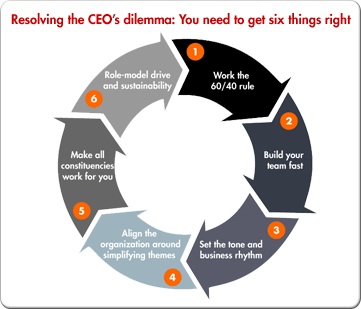Article
The job of chief executive officer has expanded dramatically in recent years, both in scope and in complexity. The companies CEOs run are likely to operate in a range of countries, in markets that have rarely been more turbulent than today. The organizations they head are no longer simple pyramids; rather they are intricate networks of overlapping jurisdictions and relationships. And CEOs' responsibilities are no longer limited to what happens inside the company. On the contrary, global sustainability and the way it shapes our lives depends as much on the actions of large corporations as on those of any government or nongovernmental organization (NGO)-maybe more so. To a greater extent than ever, CEOs bear the weight of the world on their shoulders.
This situation confronts every CEO with a series of challenges—challenges that can be rank—ordered in much the same way as Abraham Maslow's famous hierarchy of needs.
The first priority is simply to survive in the job. That is no small matter. Between 1999 and 2006 the average tenure of departing chief executive officers in the US declined from about 10 years to just over eight. About 40 percent of new CEOs last an average of less than two years. The second priority is building the business and increasing shareholder value. That is a major challenge, as only about one in 10 companies achieves sustained value creation. (Our research shows that only 12 percent of companies with revenues of more than $500 million grow revenues and profits at least 5.5 percent a year while also earning their cost of capital.) A third priority is leaving a legacy of which the CEO can be proud-a company that plays a leadership role with stakeholders, in its communities and in the world, contributing to a sustainable future rather than detracting from it.
A job with such challenges can quickly overwhelm the person who occupies it—one reason, no doubt, for the short tenure of so many chief executives. And yet as we learned in a series of interviews with CEOs, many men and women are able to assert control over the job rather than let themselves be dominated by it. They are able to meet the challenges, pursue their agendas and accomplish great things.
One key, our interviewees told us, is that they must be utterly self-disciplined, even selfish, in how they approach their work. They protect themselves from the countless people who want a piece of their time. They learn to focus on their own agenda rather than simply respond to external demands. And they follow their instincts even when it leads to replacing people on the team who don't contribute to that agenda or who suck time and energy from the group, regardless of how capable and motivated those individuals might be.
Six dilemmas-and six strategies for success
Apart from the broad challenges that come with running a large, complex organization, the job of CEO poses six specific dilemmas relating to time management and control of the agenda:
When we posed these dilemmas to the chief executives we interviewed, they responded with the insights and best practices that have enabled them to balance the multiple demands and spend more time on what really matters—establishing their leadership and moving their companies toward full potential, all while building a record and a legacy of which they can be proud.
Specifically, our interviewees mapped out six strategies for taking control of the CEO's job:
- Work the 60/40 rule
- Build your team fast
- Set the tone and business rhythm
- Align the organization around simplifying themes
- Make all constituencies work for you
- Role-model drive and sustainability
James Allen, a partner with Bain & Company in London, is co-leader of the firm's Global Strategy practice. Julian Critchlow is a partner with Bain's London office.
Additional articles appearing in this edition of the Results Brief newsletter:
The decision-driven organization
by Marcia W. Blenko, Michael C. Mankins and Paul Rogers
in Harvard Business Review
Reorganizations are popular with chief executives, who believe that making big structural changes will lead to better performance. In reality, a company's structure results in better performance only if it improves the organization's ability to make and execute key decisions better and faster than competitors.
After easy money: Managing in a new era
by Andrew Schwedel and Karen Harris
in The Wall Street Journal
As we emerge from the depths of the recession, a lot of attention naturally focuses on trying to handicap the speed and strength of the rebound. But no matter how fast the turnaround comes, success is unlikely to get easier. Executives will have to run lean and focus on their core businesses.
